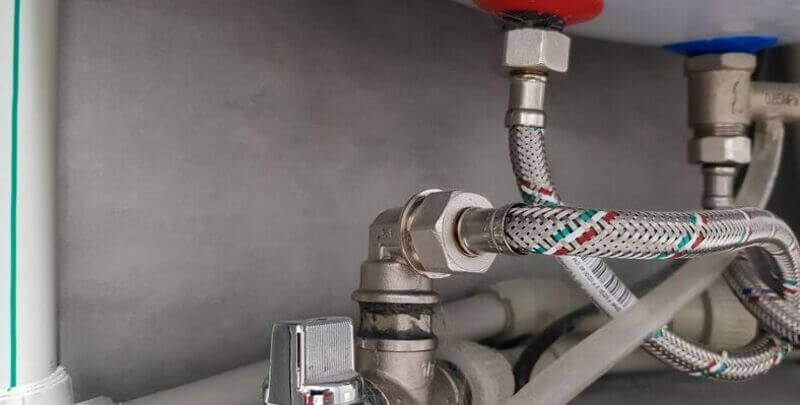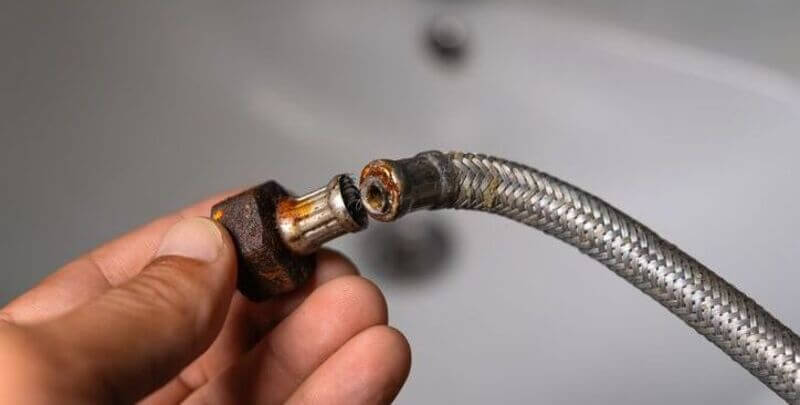
Flexi Hose Burst: Causes and How to Prevent It
Flexi hoses, also known as flexible water hoses, have become an essential part of plumbing fixtures, connecting water supply to kitchen sinks, toilets, and other appliances. Despite their convenience and widespread use, the risk of a burst flexi hose can lead to serious water damage, costing homeowners thousands of dollars.
These hoses, often made with a rubber tube inside and covered in braided stainless steel, are susceptible to wear and damage from water pressure, chemical corrosion, and physical stress. Incorrectly chosen or installed flexi hoses, especially those without proper stainless steel braiding or in high humidity environments, are prone to bursting, leading to unexpected water flooding.
To prevent such incidents, it’s crucial to understand the warning signs of wear and the importance of having flexi hoses installed by a qualified plumber. Regular checks for frayed steel threads, rust spots, and other signs of damage can avert the catastrophic aftermath of burst flexi hoses in closed cupboards and concealed areas.
What is a Flexi Hose?
A flexi hose, or flexible water hose, is a key component in connecting water supply to fixtures like kitchen sinks and toilets in homes. These hoses consist of rubber tubes encased in steel braided lengths, often with a stainless steel braid to withstand water pressure and prevent burst flexi hoses.
Designed for both hot water feed and cold supply, they come with features like pressure limiting valves to mitigate hydraulic shock and potential water damage.
However, selecting the wrong flexi hose or improper installation can lead to leaks or bursts, necessitating regular checks by a licensed plumber to avoid unexpected water damage and costly insurance claims.

Common Causes of a Flexi Hose Burst
The bursting of a flexi hose, a common issue in Australian homes, can be attributed to several factors.
- Age: The shelf life of a flexi hose plays a significant role; over an extended period, the rubber lining inside can degrade, especially in a high humidity environment, leading to a burst flexi hose. Additionally, the steel braided hose, though durable, has weak points that can expand and fray, causing leaks or bursts.
- Water pressure: This is another critical factor; without a pressure limiting valve, sudden changes in water supply pressure can strain hoses, leading to failure.
- Installation process: This factor is crucial. A professional plumber should ensure that flexible connectors are fitted correctly to avoid twisting or kinking, which can compromise the hose’s integrity. Regular checks for signs of wear, such as rust on the braided lengths or damage to the plastic coating, are essential to prevent flexi hoses from bursting.
- Ground movement and hydraulic shock: This can also contribute to stress on the hose, precipitating a burst.
Homeowners must heed professional advice, opting for quality hoses with watermark certification and adhering to the warranty period to mitigate the risk of burst flexi hoses and subsequent water damage.
Signs of an Imminent Burst Flexi Hose
Detecting the warning signs of an imminent burst flexi hose can save homeowners from extensive water damage and costly repairs.
Common indicators include visible bulging or expansion along the hose, signalling a weak point under pressure, particularly near connection points like the kitchen sink or toilet.
Regularly check for any unusual wetness or water leaks, as these can precede a major burst, potentially unleashing litres of water per minute from the main water supply.
Discoloration, cracks, or fraying on the rubber pipes or the flexible hose’s outer braiding are clear signs of deterioration.
Audible signs, like hissing or dripping sounds near isolation taps or stop taps, can also indicate internal damage leading to a leak. Immediate action, like shutting off the water and consulting a professional, can prevent further damage, avoiding the high costs associated with burst flexi hoses.
Preventative Measures to Avoid Flexi Hose Burst
To prevent your flexi hose from bursting, homeowners can take several proactive measures. Firstly, installing an isolation tap for each flexible hose allows for quick shutoff in case of a leak, preventing further damage.
Regularly inspecting flexi hoses for any signs of wear, such as bulging, cracks, or fraying, is crucial to detect issues before they lead to a burst.
Ensuring that hoses are not over-tightened at the connection points can prevent stress and strain, reducing the risk of leaks. Additionally, using hoses with a high-quality build and appropriate materials for specific applications, such as those connecting water to toilets or kitchen sinks, can decrease the likelihood of failure.
For hoses exposed to significant changes in water pressure, installing a pressure regulator can help maintain a consistent pressure level, minimising stress on the hose.
Regular maintenance checks by professional plumbers can identify potential risks and replace hoses nearing the end of their service life, ultimately proving to be a cheaper option than dealing with the tens of thousands in damage caused by burst pipes.

What to Do if Your Flexi Hose Bursts
If a flexi hose bursts in your home, immediate action is crucial to minimise water damage. First, locate and shut off the main stop tap to halt the flow of water; this tap is often near the metre or where the main service pipe enters the property.
Quickly removing any valuables and electrical devices from the affected area to prevent further expansion of damage is essential.
After stopping the water, contact a professional plumber to replace the burst flexi hose and inspect others for potential issues. Regularly monitoring flexible hoses, especially those connected to high-use fixtures like toilets, can prevent such emergencies.
Homeowners must remain vigilant about the condition of flexi hoses, which are crucial in connecting water to fixtures such as kitchen sinks and toilets.
Regular checks and maintenance of these handy hoses can prevent costly leaks and ensure the longevity and safety of your home’s plumbing system.
Please note: This information is provided for advice purposes only. Regulations differ from state to state, so please consult your local authorities or an industry professional before proceeding with any work. See our Terms & Conditions here.